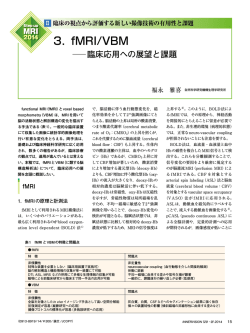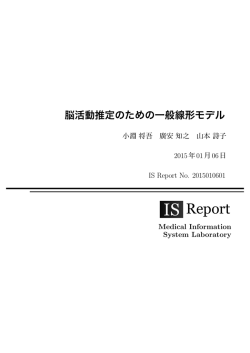
The impact of temporal compression and space selection on SVM
医療情報システム研究室 MRI 班 【文献調査】 The impact of temporal compression and space selection on SVM analysis of single-subject and multi-subject fMRI data. 大村 歩 廣安 知之 山本 詩子 2014 年 11 月 07 日 タイトル 1 一被験者および複数被験者の fMRI データの SVM 分析への一時的なデータ圧縮および関心領域選択の影響 著者 2 Janaina Mour˜ao-Miranda, Emanuelle Reynaud, Francis McGlone, Gemma Calvert, Michael Brammera 出典 3 NeuroImage, Volume 33, Issue 4, October 2006, Pages 1055-1065 アブストラクト 4 本研究では,我々はサポートベクターマシン (SVM) を使用して,fMRI データの 1 人の被験者や多数の被験者 を識別する上で一時的な圧縮 (多数の撮像を跨いだ平均) およびスペースの選択 (つまり全脳からの「関心領域」の 選択) の影響を比較した.我々の目標は,無関係の分散の成分を抑えながら,タスクを保持するように SVM を訓 練する前に適用することができる様々なデータ媒体変換を調査することである.データはブロックデザインを用 いた実験もデータである.不快画像(クラス 1),快画像(クラス 2),中性画像(クラス 3)を提示した.多数の 被験者の分析において, 「leave-one-subject-out」を用いた.つまり,各反復において我々は 1 人の被験者以外のす べてからのデータを使用して,SVM を訓練しクラス・ラベルを予測する際にその実行をテストした.1 人の被験 者の分析においては, 「leave-one-block-out」を用いた.つまり,各被験者において,実験ブロックの条件あたり 1 ブロックをランダムで選択し,残りのブロックのデータを使用して SVM を訓練した.結果,1 人の被験者内での 識別において,一時的な圧縮および関心領域選択の両方が SVM 精度を改善した.しかし,複数の被験者間での識 別においては,一時的な圧縮は SVM のパフォーマンスを改善したが,関心領域選択は効果がなかった. キーワード 5 Machine learning methods, Support vector machine, Classifiers, Functional magnetic resonance imaging data analysis 参考文献 6 6.1 一変量の統計解析手法を fMRI データに適応している文献 • Friston KJ, Holmes AP, Worsley KJ, Poline JP, Frith CD, Frackowiak RSJ, 1995, Statistical parametric maps in functional imaging: a general linear approach. Hum. Brain Mapp. 2, 189–210. 6.2 多変量の統計解析手法を fMRI データに適応している文献 • Friston KJ, Frith CD, Frackowiak RS, Turner R, 1995, Characterizing dynamic brain responses with fMRI: a multivariate approach. NeuroImage 2 2), 166–172. • McIntosh AR, Bookstein FL, Haxby JV, Grady CL, 1996, Spatial pattern analysis of functional brain images using partial least squares. NeuroImage 3, 143–157. 1 • McKeown MJ, Makeig S, Brown GG, Jung TP, Kindermann SS, Bell AJ, Sejnowski TJ, 1998, Analysis of fMRI data by blind separation into independent spatial components. Hum. Brain Mapp. 6, 160–188. 6.3 パターン認識を fMRI データ分析に用いている文献 • Cox DD, Savoy RL, 2003, Functional magnetic resonance imaging (fMRI) ”brain reading”: detecting and classifying distributed patterns of fMRI activity in human visual cortex. NeuroImage, 19, 261-270. • Carlson TA, Schrater P, He S, 2003, Patterns of activity in the categorical representations of objects. J. Cogn. Neurosci, 15, 704-717. • Wang X, Hutchinson R, Mitchell TM, 2003, Training fMRI classifiers to detect cognitive states across multiple human subjects. Proceedings of the 2003 Conference on Neural Information Processing Systems. • Mitchell T, Hutchinson R, Niculescu R, Pereira F, Wang X, Just M, Newman S, 2004, Learning to decode cognitive states from brain images. Mach. Learn, 1-2, 145-175. • LaConte S, Strother S, Cherkassky V, Anderson J, Hu X, 2005, Support vector machines for temporal classification of block design fMRI data. NeuroImage, 26, 317-329. • Mourao-Miranda J, Bokde ALW, Born C, Hampel H, Stetter S, 2005, Classifying brain states and determining the discriminating activation patterns: support vector machine on functional MRI data. NeuroImage, 28, 980-995. • Haynes JD, Rees G, 2005, Predicting the orientation of invisible stimuli from activity in human primary visual cortex. Nat. Neurosci, 8, 686-691. • Davatzikos C, Ruparel K, Fan Y, Shen DG, Acharyya M, Loughead JW, Gur RC, Langleben DD, 2005, Classifying spatial patterns of brain activity with machine learning methods: application to lie detection. NeuroImage, 28, 663-668. • Kriegeskorte N, Goebel R, Bandettini P, 2006, Information-based functional brain mapping. PANAS, 103, 3863-3868. 6.4 統計的学習理論に関する文献 • Vapnik V, 1995, The Nature of Statistical Learning Theory. Springer-Verlag, New York. 6.5 統計パターン認識のツールに関する文献 • Boser BE, Guyon IM, Vapnik VN, 1992, A training algorithm for optimal margin classifiers. D. Proc. Fifth Ann. Workshop on Computational Learning Theory, pp. 144–152. 6.6 全脳のデータを用いて SVM で識別している研究 • Mourao-Miranda J, Bokde ALW, Born C, Hampel H, Stetter S, 2005, Classifying brain states and determining the discriminating activation patterns: support vector machine on functional MRI data. NeuroImage 28 4), 980–995. • LaConte S, Strother S, Cherkassky V, Anderson J, Hu X, 2005, Support vector machines for temporal classification of block design fMRI data. NeuroImage 26(2), 317–329. 6.7 関心領域を選択して識別をしている研究 • Cox DD, Savoy RL, 2003, Functional magnetic resonance imaging (fMRI) ”brain reading”: detecting and classifying distributed patterns of fMRI activity in human visual cortex. NeuroImage, 19, 261-270. • Mitchell T, Hutchinson R, Niculescu R, Pereira F, Wang X, Just M, Newman S, 2004, Learning to decode cognitive states from brain images. Mach. Learn, 1-2, 145-175. • Wang X, Hutchinson R, Mitchell TM, 2003, Training fMRI classifiers to detect cognitive states across multiple human subjects. Proceedings of the 2003 Conference on Neural Information Processing Systems. 2
© Copyright 2026



![本文PDF [2187K] - J](http://s1.jadocz.com/store/data/000593472_1-d83f57e1a7887db4b943997e47b2e017-250x500.png)
